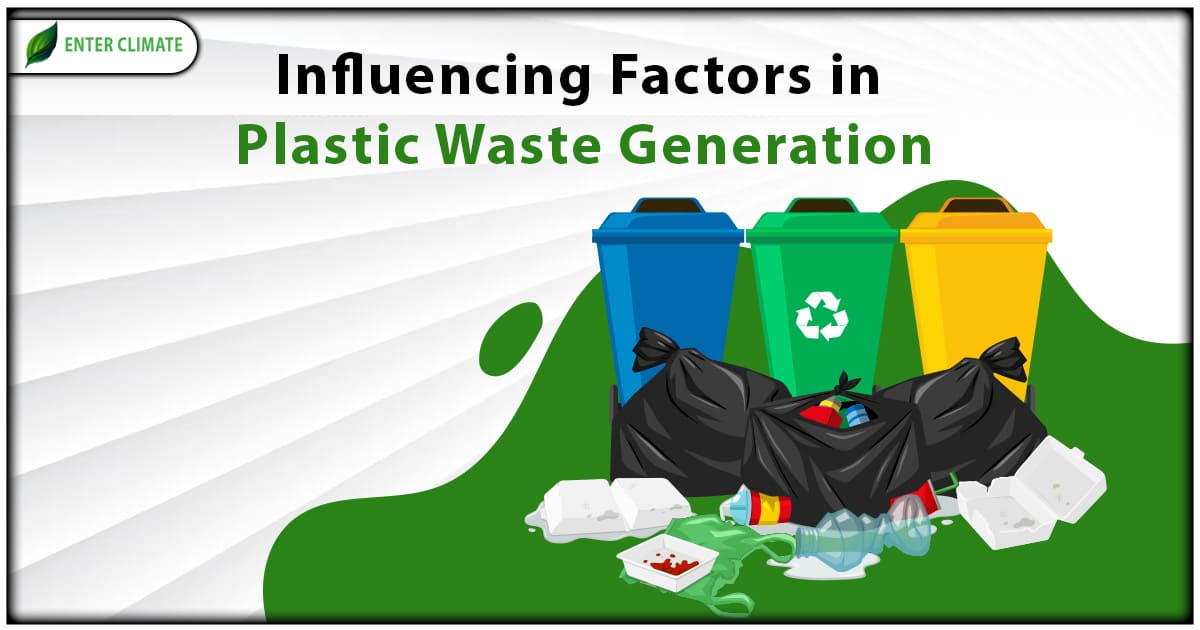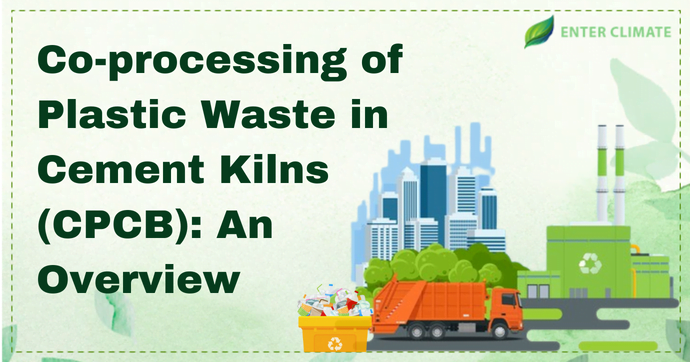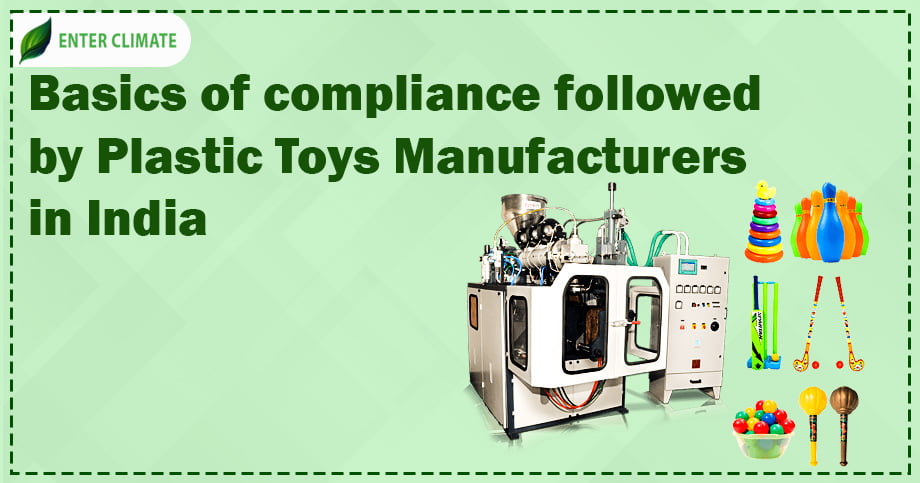Influencing Factors in Plastic Waste Generation
 07 Aug, 2023
07 Aug, 2023 
Currently, the world is confronted with the daunting task of effectively managing and recovering the vast volume of plastic waste due to the huge Plastic Waste Generation. The main reasons behind this mounting issue include a lack of expertise in handling hazardous waste, inadequate infrastructure for recycling and recovery, and a general lack of awareness about relevant rules and regulations. This accumulation of plastic waste has severe consequences on the environment and the overall ecosystem. Plastic pollution has emerged as a significant threat to both ocean and freshwater ecosystems, posing risks to the benefits humans derive from these environments. The commercial fishing industry, for instance, has witnessed a doubling of plastic debris discarded over the past 50 years, with annual figures reaching 640,000 tons, up from 340,000 tons in 1975. In this write-up, we will discuss the potential solution and high-profit business ideas that could mitigate the effects of Plastic Waste Generation on the environment.
Effects of Plastic Waste Generation
The effects of Plastic Waste Generation are as follows:
- Plastics pose a significant risk to the survival of numerous wildlife species, affecting almost 700 species globally.
- Bigger plastic items, like fishing nets, ensnare and harm wildlife, leading to their destruction.
- Smaller plastic pieces ingested by wildlife reduce their overall fitness by causing a decrease in health and well-being.
- Plastic debris can retain toxins, prolong their presence in the environment, and accumulate up to 106 times more organic pollutants than the surrounding seawater. Chemicals present in plastic waste, such as PCBs, result in reproductive disorders or death, increase susceptibility to diseases, and disrupt hormone levels.
Sources of Plastic Waste Generation
In our contemporary world, plastic products play a vital role and are indispensable to modern life. However, the exponential rise in plastic production has resulted in an overwhelming amount of plastic waste[1], surpassing our ability to manage it efficiently. The sources of Plastic Waste Generation are as follows:
Household Wastes
Household waste, also referred to as residential waste, primarily consists of disposable materials generated by households. It includes items such as shopping bags, food packaging, printed materials, diapers, vegetable scraps, animal waste, and more. This waste stream encompasses both hazardous and non-hazardous components. Non-hazardous waste comprises food waste, paper, bottles, etc., while hazardous waste includes plastics, dry cells, electronic waste, and medical waste (MW). Hazardous waste contains toxic organic compounds, high concentrations of heavy metals, and ozone-depleting substances. It may also possess flammable or explosive properties, necessitating special collection and disposal procedures.
Industries
Industrial plastic wastes result from extensive manufacturing, processing, and packaging activities carried out in various industries. These plastics are sourced from sectors such as demolition and construction, electrical and electronics, automotive, packaging, and small to medium enterprises. The advantage lies in the fact that plastics from these industries are generally clean and uncontaminated, and they are available in large quantities. However, proper guidelines and regulations are still necessary for their disposal and recycling to ensure maximum utilisation while minimising environmental damage.
Municipal solid waste
Municipal solid waste (MSW), is a heterogeneous mixture containing recyclable, degradable, and hazardous materials. For managing homogeneous plastic wastes from industries effectively, palletisation and remoulding techniques prove to be simple and efficient alternatives to dumping or incinerating them along with general MSW. However, heterogeneous plastics with mixed resins are unsuitable for reclamation due to the individual processing requirements of each resin in terms of temperature and pressure.
Agriculture
In modern times, a significant amount of plastic is utilised for nets and coverings to safeguard crops against adverse weather conditions, insects, and animals. However, the escalating pollution caused by excessive plastic usage presents an opportunity as these plastics can be easily collected and processed. Unfortunately, only a small portion of agricultural plastic waste is currently being recycled, and this varies significantly from one country to another, depending on the availability of suitable facilities at the regional level. Therefore, a large portion of agricultural plastic waste is either buried in the soil, burned indiscriminately in fields, or discarded on the farmlands, leading to a considerable portion ending up in landfills, rivers, or canals.
Medical Wastes
With the advancement of modern medical technologies and increased healthcare coverage, there has been a substantial rise in the generation of medical plastic waste (MPW). Proper and environmentally friendly disposal methods for MPW, including items like personal protective equipment (PPE), gloves, syringes, and medicine coverings, are urgently required. During the COVID-19 outbreak, various plastic-based PPE played a critical role in safeguarding people.
The coronavirus pandemic has led to an unprecedented surge in the use of single-use plastic (SUP), such as protective hospital suits, gloves, face masks, hand sanitiser bottles, plastic takeout bags, and containers for food and pharmaceutical products, as well as reagent kits, among others.
Adverse Effects of Plastic Waste Generation
The adverse effect of Plastic Waste Generation includes:
Soil
After being collected from households, offices, business centres, and industries, plastics are taken to a secondary transfer station where sorting is carried out. Depending on the available infrastructure and technologies, the plastics are either recycled or reused. Alternatively, they may be discarded in open spaces, sent to landfill sites, or burned openly. When plastics become integrated into the soil matrix, they can alter soil porosity and binding properties, affecting soil aggregation and water dynamics. Plastic wastes, particularly microplastics (MPs), can interact with various soil properties. Furthermore, plastics hinder the growth of earthworms and other beneficial microorganisms, leading to soil infertility. The addition of microplastics to the soil can also stimulate soil enzymes.
Living Beings and Environments
When plastic is dumped in open landfills, it undergoes the formation of microplastics (MPs) due to various environmental factors such as pressure, humidity, and temperature. MPs can easily disperse and mix with the environment, including soil, water, and storm systems. This leads to their accumulation in the human body through various exposure routes like consuming contaminated food, inhaling dust, and water contamination. The soil pollution with MPs poses significant health and ecological risks, making it a pressing concern that requires proper attention.
Additionally, marine species like crabs, oysters, mussels, and sea cucumbers ingest microplastics, and when humans consume these seafood items, they introduce MPs into their bodies. This affects the food’s taste and makes it more toxic since these plastic-contaminated organisms contain harmful compounds like formaldehyde, benzene, and dioxins. Furthermore, some plastics also contain additives such as ultraviolet stabilisers and artificial pigments, which can cause serious health issues like weight gain, endocrine disruption, insulin resistance, and cancer.
Marine Environment
The vast accumulation of plastic waste poses a significant threat to marine life and disrupts the marine ecosystem. Microorganisms like copepods and zooplankton in the oceans play a crucial role in absorbing 30% of CO2 from the environment, contributing to mitigating greenhouse gas emissions. Ensuring their survival in the marine environment is essential.
The major sources of marine pollution are land-based, and a report suggests that coastal areas (within 50 km of the coastline) inhabited by human populations are the primary contributors to this pollution. Apart from land sources, plastic pollution in the marine environment also arises from rivers, tides, and coastline sources. Due to the buoyancy effect, plastics tend to float on the ocean surface, and wind waves cause them to converge at the centres of oceanic gyres or basins. As a result, plastic pollution is more concentrated at the ocean’s centre and then distributed around its periphery.
Solution to Mitigate Plastic Waste Generation
The Approach of Circular Economy
The concept of Circular Economy (CE) enhances the effectiveness and efficiency of current marine plastic pollution policies. CE aims to minimise material and energy flows through the system by promoting eco-effectiveness and transforming previously wasted materials into valuable resources. The Circular Economy model consists of two cycles: biological and technical cycles. In the biological cycle, life processes are reclaimed through composting and anaerobic digestion. On the other hand, the technical cycle employs strategies like reuse, repair, remanufacture, refurbishment, and recycling. Implementing a Circular Economy in industries involves three approaches: resource switch, which prioritises renewable and non-harmful inputs; resource circularity, focused on the reuse and recovery of end-of-life materials; and resource recovery, ensuring efficient utilisation of plastic resources.

Alternative business ideas to single plastic use
Starting from July 1st, 2022, India enforced a nationwide ban on manufacturing, importing, stocking, distributing, selling, and using specific single-use plastic items with low utility and high littering potential. The purpose of this ban is to address the issue of plastic waste caused by single-use plastics. However, this ban has posed a challenge for small and medium-scale industries involved in manufacturing and related businesses of these items, as they now need to explore alternative materials.
In India, several alternatives to single-use plastics are available based on specific criteria. One such alternative is degradable plastic, which involves the production of additive-based polyolefin compounds converted into films and then into carrying bags, pouches, etc. These degradable plastics can be classified into different types:
- Photodegradable or oxo-degradable plastics break down into small pieces when exposed to sunlight or oxygen.
- Semi-biodegradable plastics, such as blends of starch and polyethene (bioplastics).
- 100% biodegradable materials, which are consumed by microorganisms like bacteria, fungi, and algae. These microorganisms break down the polymer chain, converting it into biomass.
Bio-plastics
Bioplastic serves as an eco-friendly alternative to single-use plastic, as it is biodegradable and made from natural materials. This emerging industry is gradually replacing disposable petroleum-based plastic items like cups, cutlery, packaging, containers, and straws, contributing to excessive waste.
There are various types of bioplastics available:
- Starch-Based Bioplastic: Utilising starch from sources like corn, potato, tapioca, pea, wheat, or rice, this type of bioplastic is used to produce disposable cups, plates, spoons, etc. Starch-based plastics can be blended with petroleum-based polymers or biopolymers to create composite and degradable materials that can be moulded or extruded using standard processing machinery.
- Cellulose-Based Bioplastic: Produced from cellulose esters and derivatives, cellulose plastics find applications in thermoplastics, extruded films, eyeglass frames, electronics, sheets, rods, and more, with moulding materials being the dominant application segment.
- Polylactic Acid (PLA) based Bioplastic: PLA, similar to polypropylene, polyethene, or polystyrene, is biodegradable and cost-efficient to produce. It can be manufactured using existing equipment designed for petrochemical industry plastics and is in high demand in the packaging industry due to its versatility.
- Polyhydroxyalkanoates (PHA) based Bioplastic: PHA, a group of biodegradable polyesters synthesised by microorganisms, is highly sought after in the biomedical and agricultural fields due to its biodegradable and biocompatible properties.
- Compostable Plastics: Compostable plastics, derived from renewable materials, have great potential as the next generation of plastics. They break down through composting, making them environmentally friendly. Compostable plastic bags can be used as a valuable substitute for polythene bags.
Plant-based alternatives like wood, bamboo, cotton, banana leaves, and jute offer eco-friendly options to produce many of the banned products and mitigate the effects due to the hast Plastic Waste Generation. There has also been an increase in demand for paper bags in India.
The process of setting up the bio-degradable plastic manufacturing businesses
Setting up any of the businesses requires essential prerequisites such as land, machinery, capital, and a thorough understanding of the manufacturing process. Even if an entrepreneur possesses a comprehensive understanding of the business’s aspects, they must still comply with the necessary authorisation and licensing requirements.
To establish a bioplastic or compostable plastic item manufacturing business, the following licenses are necessary:
- CPCB Certificate for Manufacturing Compostable Plastic Products
- Consent NOC: Obtaining Consent to Establish (CTE) and Consent to Operate (CTO) from the relevant State Pollution Control Board (SBCB) or Pollution Control Committee (PCC) under the Air Act and Water Act.
- EPR Authorization from CPCB: Plastic producers, importers, brand owners (PIBO), and plastic waste processors need EPR authorisation.
- Additional Licenses and Permits Needed: In addition to the specific licenses and authorisations, several essential registrations and certificates are required for manufacturers of compostable/biodegradable plastics, including:
- Industry Incorporation Certificate
- Registration
- Fire NOC
- BIS Certificate
- Factory’s License
Necessary documents required for the business
For obtaining a CPCB Certificate for compostable plastic manufacturing, the following documents are necessary:
- Duly filled out Form A for obtaining a certificate from the CPCB for compostable plastic by the manufacturer.
- Production details, including the manufacturing capacity for compostable plastics, end products, and byproducts.
- Registration certificate for the production of compostable plastic from the concerned State Pollution Control Board or Pollution Control Committee.
- Consent under Air and Water Act from the relevant board or committee.
- Flow diagram and manufacturing process.
- Test reports as per Indian Standards IS/ISO: 17088.
- Proof of pollution control devices/measures.
- Memorandum of Association.
Conclusion
Plastic waste generation has become a pressing global issue with significant environmental, social, and economic implications. The exponential growth in plastic production and consumption, coupled with inadequate waste management practices, has led to the proliferation of plastic waste in our oceans, lands, and ecosystems. This pervasive pollution severely threatens wildlife, marine life, and human health. Addressing the plastic waste problem requires a multi-faceted approach, including reducing single-use plastics, promoting recycling and circular economy initiatives, implementing effective waste management systems, and raising awareness about the importance of responsible plastic usage. Only through collective efforts and conscious actions can we hope to curb the plastic waste crisis and preserve the planet for future generations. It is recommended to take expert advice for the setup of the businesses that are alternatives to the single-use plastic manufacturing business to get to know about the exact licenses and documents that would be required for the business setup.
FAQs
This accumulation of plastic waste has severe consequences on the environment and the overall ecosystem.Plastic pollution has emerged as a significant threat to both ocean and freshwater ecosystems, posing risks to the benefits humans derive from these environments.
In India, several alternatives to single-use plastics are available based on specific criteria. For example – bio-degradable plastic, which involves the production of additive-based polyolefin compounds converted into films and then into carrying bags, pouches, etc.
Plastic wastes are generated from household waste, industries, Municipal Solid Waste, Agriculture, and Medical Waste.
Some unknown facts about plastic waste are that plastic takes about 50- 80 years to decompose, and over 13 billion plastic bottles get disposed of each year.
The highest recycling country for plastic is South Korea and Germany.
Plastic waste is not recycled as it is difficult to collect and releases toxins.
Plastics contain additives such as ultraviolet stabilisers and artificial pigments, which are causing serious health issues like weight gain, endocrine disruption, insulin resistance, and cancer.
Only 30% of the total generated plastic waste, which is 3.5 metric tonnes, gets recycled in India.
Plastic waste ends up in landfills and aquatic bodies.
Humans who produce and manufacture these plastic products are responsible for plastic pollution.
Read our Article: Co-Processing Of Plastic Waste In Cement Kilns
Categories
Latest Post
Air pollution Dispersion Modeling
Natural Disaster Risk Assessment
Endangered Species Protection
Aquifer Recharge Project
Sustainable Sanitation Solutions














